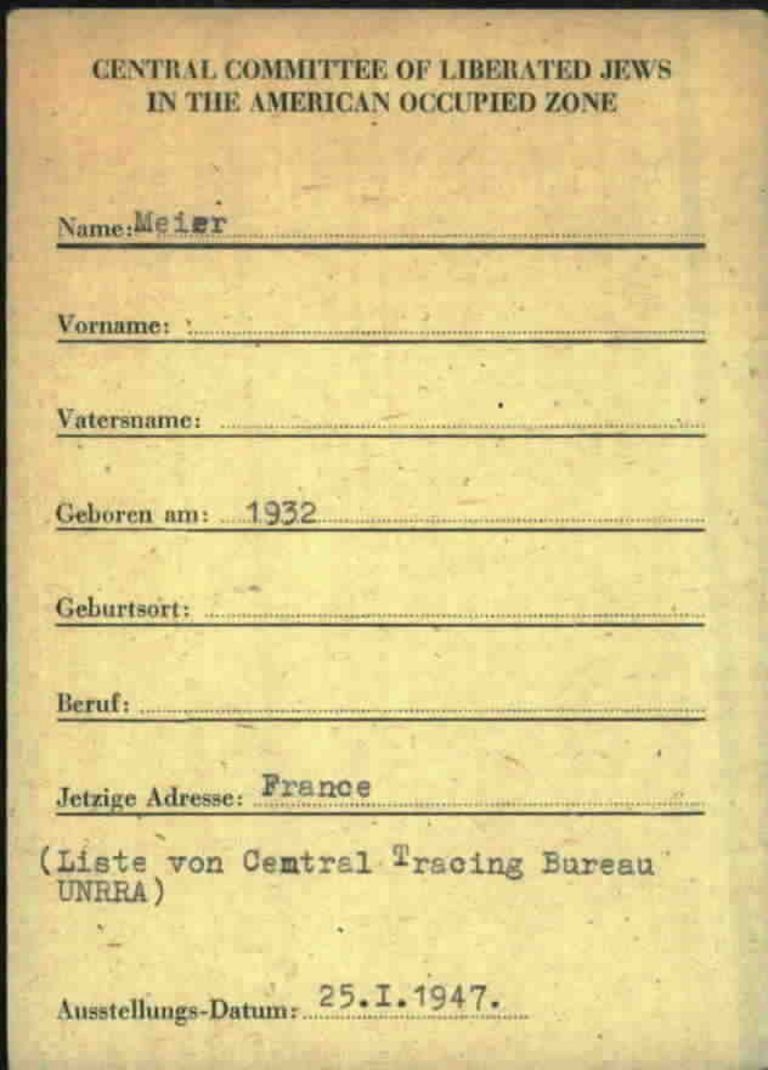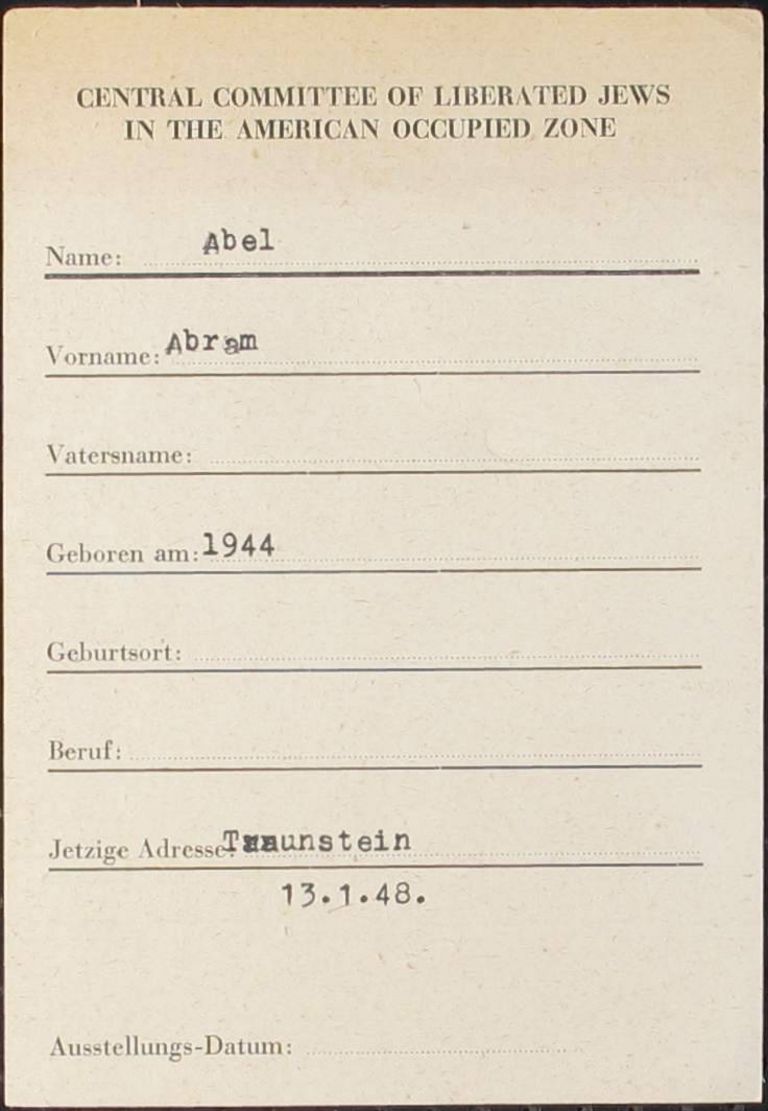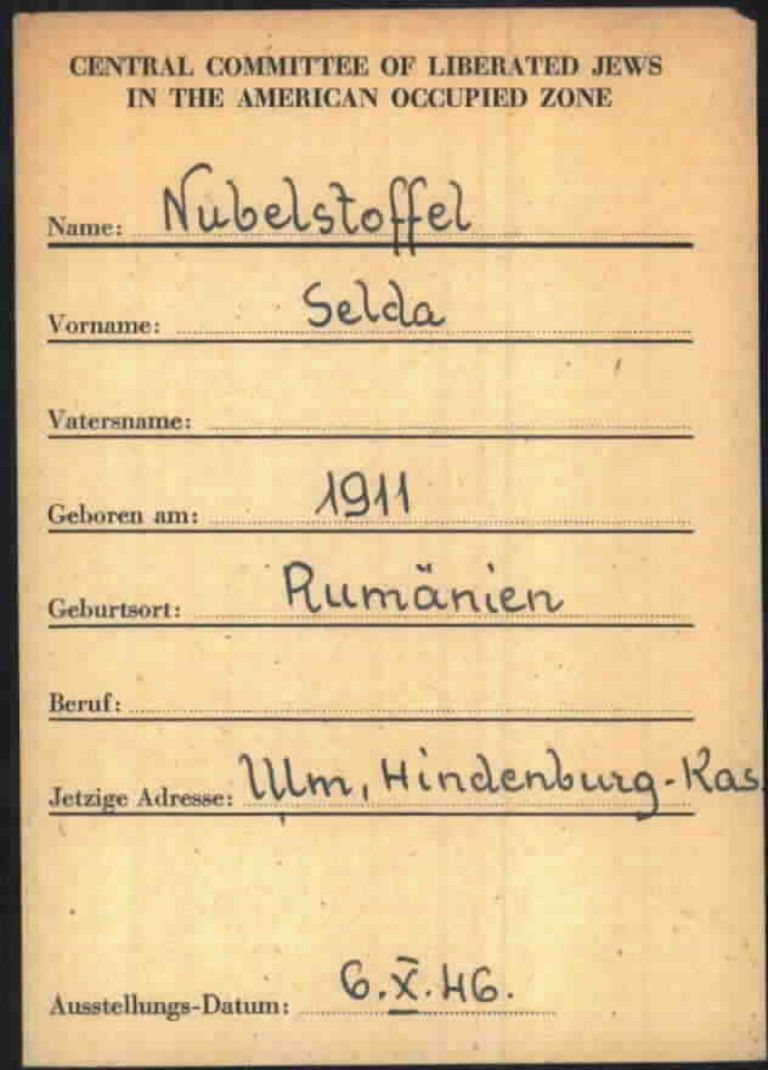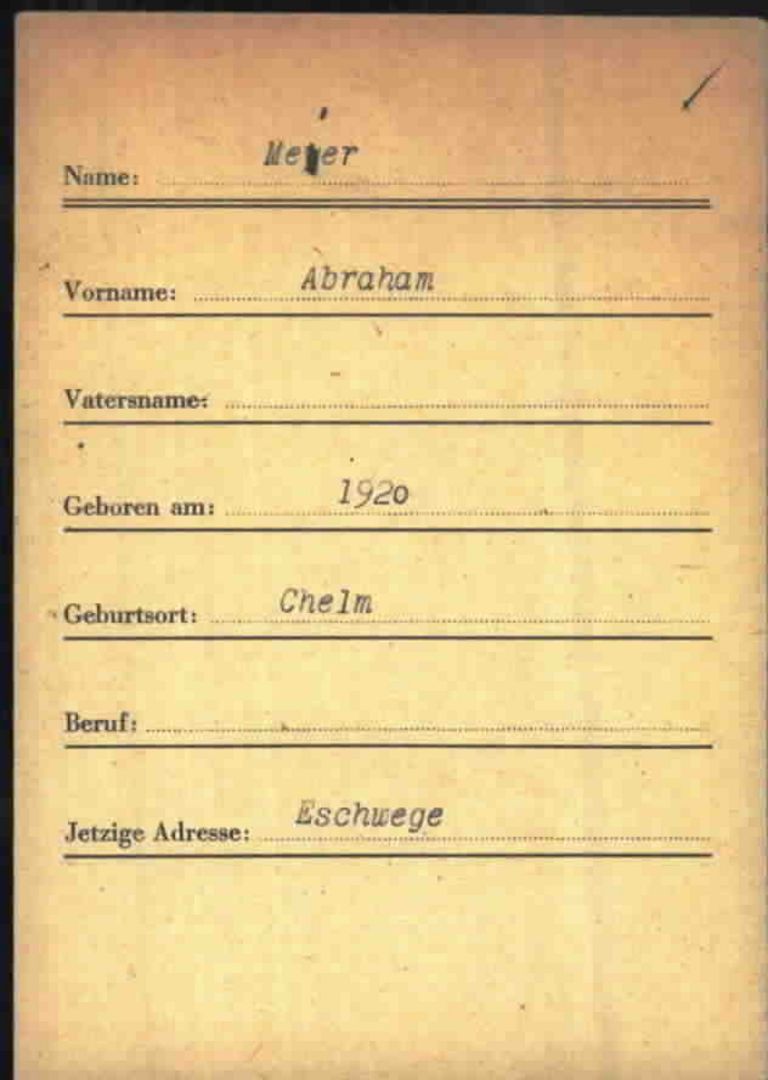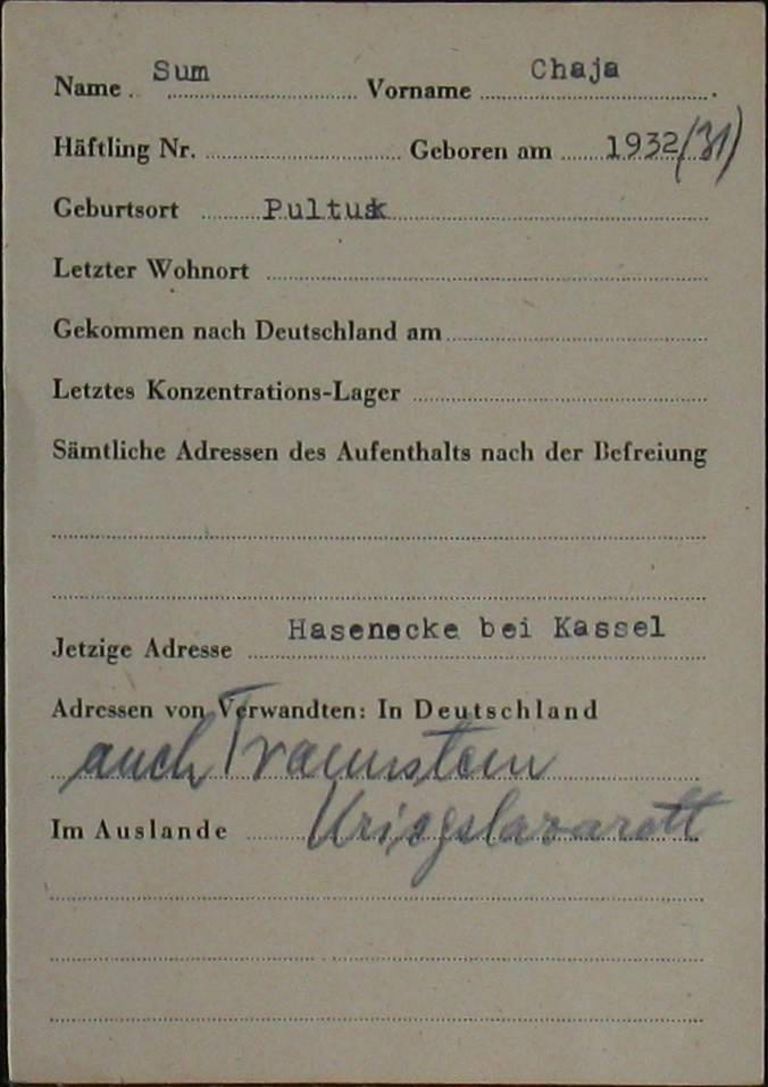Page of
Page/
- Reference
- Intro
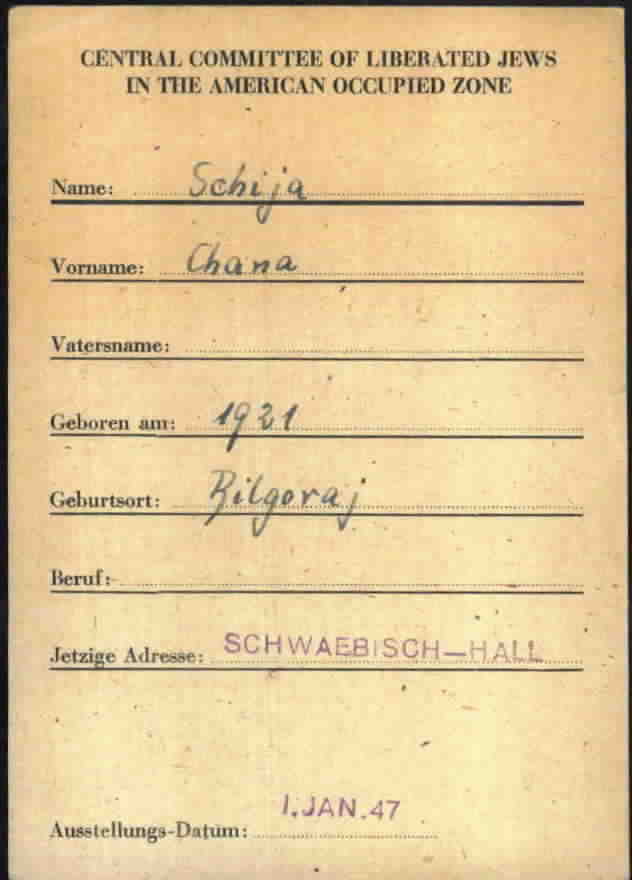

Holocaust survivors in the US occupation zone established the Central Committee of Liberated Jews in the American Occupied Zone in Germany to give a voice to their concerns. Along with many other activities, the employees of the Central Committee in Munich created a central card index. This enabled them to provide information about Jewish survivors in Germany, primarily in the French and US zones. On the index cards, they recorded personal details and information about where an individual was living.
There are three versions of the cards: one with the name of the organization, one without, and a third which additionally asked about the individual’s path of persecution.
Holocaust survivors in the US occupation zone established the Central Committee of Liberated Jews in the American Occupied Zone in Germany to give a voice to their concerns. Along with many other activities, the employees of the Central Committee in Munich created a central card index. This enabled them to provide information about Jewish survivors in Germany, primarily in the French and US zones. On the index cards, they recorded personal details and information about where an individual was living.
There are three versions of the cards: one with the name of the organization, one without, and a third which additionally asked about the individual’s path of persecution.
Questions and answers
-
Where was the document used and who created it?
Holocaust survivors who were living in the US occupation zone after their liberation soon began to organize themselves. Just seven weeks after the end of the war, on July 1, 1945, they founded a Central Committee of Liberated Jews in Bavaria. This developed into the Central Committee of Liberated Jews in the American Occupied Zone in Germany (CCLJ) in January 1946. The Central Committee represented the interests of Jewish survivors when dealing with the military government and UNRRA, and it maintained contact with aid organizations.
Within the Central Committee in Munich, there was a special department responsible for tracing inquiries. The department’s employees – who were Holocaust survivors themselves – created a central index for Jews living in the US and French occupation zones. They kept lists of names for the British zone. With the help of the index in particular, they could quickly check whether a person’s location was known when they received a tracing inquiry. - When was the document used?
Although the Central Committee was already established in July 1945, most of the central index cards examined so far were filled out in 1947. Two other observations indicate that the employees did not start the central index immediately after the war ended. First, the central index does not include the names of the Jewish survivors published by the Central Committee in 1945 in a book of several volumes with the title Shārit ha-plātah (“counted remnant”). And second, the Central Committee of Liberated Jews in the American Occupied Zone, the name of which is printed in the header of some of the cards, was not founded (or renamed) until January 1946. The previous name – the Central Committee of Liberated Jews in Bavaria – is not found on any cards.
The Central Committee wound down as more and more survivors had the opportunity to emigrate in the late 1940s. After Israel was founded and it became easier to enter the USA, the Jewish DP camps began to empty out and the Central Committee gradually disbanded. It officially ended on December 17, 1950. By this point at the latest, the central index was no longer being used by the Central Committee. It is not possible to say whether the index was sent directly from Munich to the International Tracing Service (ITS), the predecessor to the Arolsen Archives. But the stamp on the back of the cards reveals that ITS employees filed the cards in August and September 1954. - What was the document used for?
After the liberation, the Allies initially housed the surviving Jews with non-Jewish DPs. At first, they did not recognize the special emergency situation of the Jews. After years of persecution, Jewish survivors were extremely physically and psychologically fragile. Additionally, in many cases their families and communities had been completely wiped out. For Jews from Central and Eastern Europe in particular, it was almost impossible to return home and pick up where their lives had left off. To draw attention to this situation and establish a better position for negotiating with military officials and aid organizations, Jewish survivors in the DP camps – like other national DP groups – began to organize themselves. They founded camp and regional committees and elected central committees. The Central Committee of Liberated Jews in Bavaria – which expanded in January 1946 to cover the whole US occupation zone – was based in Munich from July 1945.
The US zone had become a magnet for Jewish DPs. In the wake of a report by the US lawyer Earl G. Harrison on the situation of the Jewish DPs, the responsible officials had set up special DP camps for Jews and ensured that they received better care. From 1946, many people known as “infiltrees” also traveled to the US occupation zone. These were mostly Central and Eastern European Jews who had either survived the war in the Soviet Union or had initially gone home after their liberation, only to flee from antisemitic attacks and return to the western occupation zones of Germany. The US zone – which included Bavaria, Hessen and parts of what is now Baden-Württemberg – was the only place they could acquire the DP status they needed to receive support from UNRRA and later the IRO. Additionally, many Jewish aid organizations settled in Munich in particular. As a result of all this, the number of Jewish DPs in the US zone rose from around 40,000 to around 140,000 in 1946 alone. Huge DP camps were established, such as one in Wetzlar for 4,000 Jewish DPs, in Bad Reichenhall for 5,000 and in Pocking for 6,000. In addition, a quarter of all Jewish DPs in the US zone were “free-living DPs” who lived not in camps but in private accommodations.
The search for relatives, friends and acquaintances was an important concern for the Jewish DPs. The Central Committee therefore immediately began compiling lists of survivors. They distributed these in Germany and abroad, to aid organizations and in the DP camps. The employees also created a central index, which was a card file for “Jews living in Germany, especially in the U.S. and French zone” (6.1.1/82511347/ITS Digital Archive, Arolsen Archives). The employees of the Central Committee filled out a central index card for every Jewish DP they were aware of. Jewish survivors in the British occupation zone were recorded on lists instead. With the help of the index and the lists, the Central Committee responded to tracing inquiries from around the world.
- How common is the document?
Researchers estimate that there were around 140,000 Jewish DPs in the US zone, fewer than 15,000 in the British zone and around 1,000 in the French occupation zone. Since the Jewish survivors in the US and French zones are recorded in the central index, theoretically there must have been around 141,000 cards. But it is not possible to say whether every single person actually had a card. Since the International Tracing Service (ITS), the predecessor to the Arolsen Archives, needed the cards in order to search for people, ITS employees organized the central index cards using an alphabetical-phonetic system and placed them in a large general card file. This postwar card file (Nachkriegszeitkartei, Collection 3.1.1.1) now comprises around 3.5 million documents. Filing them in this way made it possible to respond to tracing inquiries more quickly because the employees only needed to look in one card file instead of several. Unfortunately, this also means it is no longer possible to determine how many Central Committee cards have been preserved. But in the near future, modern computer technology will find the answer: clustering techniques will make it possible to virtually reassemble the index of the Central Committee – as well as other card files.
- What should be considered when working with the document?
The employees of the Central Committee did not update the information in the central index. But since Jewish DPs often moved from one camp to another and usually emigrated in the end, the cards are like a snapshot in time. They show that an individual had survived the war and where the person was living when the card was created. The imprecise information poses a difficulty, however. Since even the birthdate is often only given as a particular year, there can sometimes be confusion about an individual’s identity.
If you have any additional information about these cards, we would appreciate it very much if you could send your feedback to eguide@arolsen-archives.org. New findings can always be incorporated into the e-Guide and shared with everyone.
Help for documents
About the scan of this document <br> Markings on scan <br> Questions and answers about the document <br> More sample cards <br> Variants of the document
